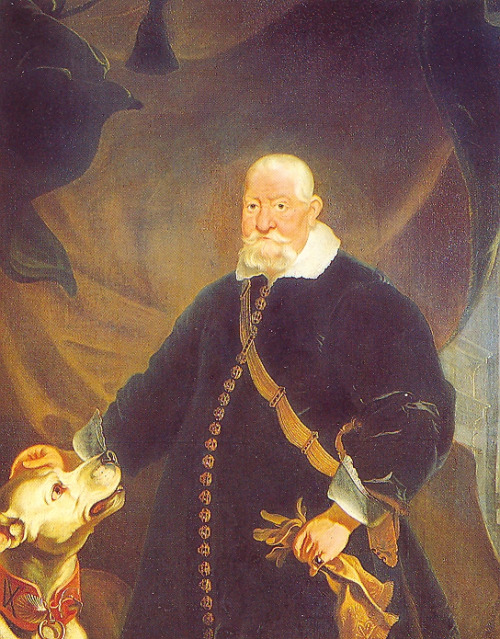
Portrait by Franz Luycx (1652)
Elector of Saxony.
Although a Lutheran prince he maintained an unusually close relationship with Ferdinand II and refused to back the bid of Friedrich V to take power in Bohemia. In the aftermath of the Protestant defeat at the White Mountain (1620), Georg imposed a relatively tolerant settlement on Lusatia and Silesia, at least as compared to what Maximilian I did in Bohemia and Moravia. He formed the Leipziger Bund to represent a third way, a neutral force in Germany between the Habsburgs and Sweden. He was pulled back into the war by Gustavus Adolphus, the impact of the sack of Magdeburg, and the move by Johann Tilly’s army into Saxony (September 4, 1631) to eat out that country as he moved north to meet the Swedish invasion. Within a week, he allied the Bund with Sweden. However, he fled the field of battle at First Breitenfeld (1631). He was always deeply suspicious of Sweden: he saw himself, not Gustavus, as the natural leader of Germany’s Protestants. He was also convinced that the best way to remove foreign armies from his lands was to make peace with the Emperor. And he was deeply influenced by the pro-Imperial Count Schwarzenberg. After Nördlingen (1634) he abandoned the Swedish alliance and reconciled with Ferdinand. Some of Georg’s early commitments to preserve the traditional liberties of the Silesian Estates were incorporated in the Peace of Westphalia (1648).
#
Swedish King Gustavus Adolphus at last entered the war, seeing an expansion of Swedish power as nicely linked to the Protestant cause in Germany. Not all Protestants agreed: Johann Georg wanted to stay neutral, but was compelled to join the coalition by Swedish occupation of Saxony. Likewise, Georg Wilhelm of Brandenburg at first refused to allow Swedish troops to use his territory, until Gustavus marched uninvited to take the fortress at Küstrin, then west to Berlin to capture the fortress of Spandau and force Brandenburg into a growing coalition of the unwilling and the mercenary. This move against the fortresses of north Germany secured the confluences of the major navigable rivers, which permitted Gustavus to move his artillery train down river and closer to the Habsburg heartland and to supply his armies with food and fodder gathered in the north. On April 13, he stormed Frankfurt an der Oder, smashing eight Imperial regiments and taking the city. The next month Magdeburg fell to Tilly, whose men put its population to the sword when Gustavus failed to relieve the city. The atrocity—the worst of the war—actually strengthened Gustavus by raising levels of fear and resolve among German Protestants.
By May 1631, Gustavus had cleared Pomerania of Imperial armies and garrisons, while in Mecklenburg only the city of Greifswald held out against him. Gustavus marched into Saxony, forcing Johann Georg to join him and swelling the ranks of his army by a further 12,000 men. With his strategic rear and supply lines secured he moved south to do battle with Tilly’s army, which had taken Leipzig a few days earlier. The two armies met at First Breitenfeld (September 17, 1631), where Gustavus won a smashing victory despite being abandoned early in the fight when his reluctant Saxon allies fled in panic and en masse.